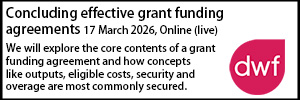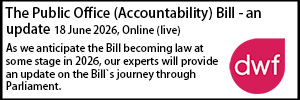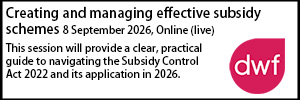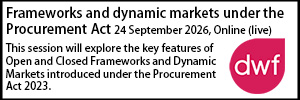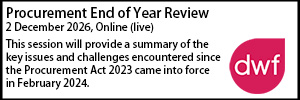Spot the signs
- Details
Martin Vincent examines the recent Traffic Signs case, where the High Court concluded that the adoption of a 40% quality measure did not accord with the obligations of objectivity and transparency.
In the case of Traffic Signs & Equipment Ltd v Department for Regional Development, the Central Procurement Department of the Department of Finance & Personnel invited tenders in April 2010 in respect of the supply and delivery of permanent and temporary road traffic signs and signposts.
The evaluation criteria specified lowest price (with a weighting of 60%) and service delivery (with a weighting of 40%). The service delivery criterion was divided into three sub-criteria: delivery methods, environmental and complaints.
The plaintiff submitted the lowest price on nine of the available 21 contracts. However, its scores for service delivery were lower than those of other bidders. The plaintiff was awarded two contracts and another tenderer (PWS) was awarded 18 contracts.
The plaintiff argued that the process was not objective because of the 60/40 split which involved evaluation of the tenders on the basis of 60% price and 40% quality. The plaintiff had previously alleged that the evaluation criteria had been modified over the years to move away from a simple price assessment to one more heavily weighted to quality. The plaintiff alleged that this was a mechanism to favour PWS. An audit investigation had found no basis for these allegations.
The High Court noted that:
- Contracts should be awarded on the basis of objective criteria which ensure compliance with the principles of transparency, non-discrimination and equal treatment. The overall task in the procurement exercise was to determine the most economically advantageous tender for the contracting authority.
- There must be sufficient transparency to ensure that the tenderers are reasonably informed of the criteria and arrangements which will be applied to identify the most economically advantageous tender.
- The price aspect of the assessment is objective and transparent. The stated quality criteria are objective matters although their assessment, inevitably, includes a subjective element. However the price and quality criteria must also be considered in combination because it is the overall assessment that determines the most economically advantageous tender.
- Objective criteria must be capable of justification as relevant to the determination of the most economically advantageous tender. The balance between relevant criteria must be capable of justification as appropriate to the determination of the most economically advantageous tender.
- The prospect of significant impact of a criterion (or criteria) on the overall assessment may require explanation in order to comply with the obligations of objectivity and transparency. Tenderers must be reasonably informed of the criteria and arrangements which will be applied to identify the most economically advantageous tender. It may not be sufficient merely to state the criteria and their weightings. The potential impact of a qualitative criterion may require particular attention as it includes a subjective element in the assessment.
- In the circumstances of the present case the allocation of 40% of the marks to the quality assessment requires justification if the criteria are to be seen to be objective and transparent. No justification was offered for the conclusion that 40% of the marks be allocated to quality.
- Given the history of the traffic signs contracts and of concerns about quality assessment and subjectivity, the introduction of Sector 9A accreditation (which had effectively removed the need for quality assessment) and the potential impact of the marking arrangements when 40% of marks are accorded to quality, the final adoption of a 40% measure of quality in this case requires explanation and justification. This is particularly true where it can be demonstrated that the arrangements for quality assessment effectively determined the allocation of the contracts and secured the award of those contracts to the tenderer who in broad terms was submitting higher prices.
The High Court, therefore, concluded that the adoption of the 40% quality measure did not accord with the obligations of objectivity and transparency. However, in the absence of an exercise that determines where the balance between price and quality should lie, the High Court was not able to determine that the adoption of a 40% quality measure constituted a manifest error.
The High Court held, on the basis of the evidence, that there was no basis for the plaintiff's allegations that there had been a manifest error in the scoring of the bids and the application of the quality criteria. Further, the High Court was satisfied that there was no manifest error in the evaluation panel's conclusion that the plaintiff required a “registration of carriage” certificate and the marking down of the bid accordingly.
Martin Vincent is a solicitor at Weightmans. He can be contacted on 0161 214 0553 or by email at
Martin Vincent examines the recent Traffic Signs case, where the High Court concluded that the adoption of a 40% quality measure did not accord with the obligations of objectivity and transparency.
In the case of Traffic Signs & Equipment Ltd v Department for Regional Development, the Central Procurement Department of the Department of Finance & Personnel invited tenders in April 2010 in respect of the supply and delivery of permanent and temporary road traffic signs and signposts.
The evaluation criteria specified lowest price (with a weighting of 60%) and service delivery (with a weighting of 40%). The service delivery criterion was divided into three sub-criteria: delivery methods, environmental and complaints.
The plaintiff submitted the lowest price on nine of the available 21 contracts. However, its scores for service delivery were lower than those of other bidders. The plaintiff was awarded two contracts and another tenderer (PWS) was awarded 18 contracts.
The plaintiff argued that the process was not objective because of the 60/40 split which involved evaluation of the tenders on the basis of 60% price and 40% quality. The plaintiff had previously alleged that the evaluation criteria had been modified over the years to move away from a simple price assessment to one more heavily weighted to quality. The plaintiff alleged that this was a mechanism to favour PWS. An audit investigation had found no basis for these allegations.
The High Court noted that:
- Contracts should be awarded on the basis of objective criteria which ensure compliance with the principles of transparency, non-discrimination and equal treatment. The overall task in the procurement exercise was to determine the most economically advantageous tender for the contracting authority.
- There must be sufficient transparency to ensure that the tenderers are reasonably informed of the criteria and arrangements which will be applied to identify the most economically advantageous tender.
- The price aspect of the assessment is objective and transparent. The stated quality criteria are objective matters although their assessment, inevitably, includes a subjective element. However the price and quality criteria must also be considered in combination because it is the overall assessment that determines the most economically advantageous tender.
- Objective criteria must be capable of justification as relevant to the determination of the most economically advantageous tender. The balance between relevant criteria must be capable of justification as appropriate to the determination of the most economically advantageous tender.
- The prospect of significant impact of a criterion (or criteria) on the overall assessment may require explanation in order to comply with the obligations of objectivity and transparency. Tenderers must be reasonably informed of the criteria and arrangements which will be applied to identify the most economically advantageous tender. It may not be sufficient merely to state the criteria and their weightings. The potential impact of a qualitative criterion may require particular attention as it includes a subjective element in the assessment.
- In the circumstances of the present case the allocation of 40% of the marks to the quality assessment requires justification if the criteria are to be seen to be objective and transparent. No justification was offered for the conclusion that 40% of the marks be allocated to quality.
- Given the history of the traffic signs contracts and of concerns about quality assessment and subjectivity, the introduction of Sector 9A accreditation (which had effectively removed the need for quality assessment) and the potential impact of the marking arrangements when 40% of marks are accorded to quality, the final adoption of a 40% measure of quality in this case requires explanation and justification. This is particularly true where it can be demonstrated that the arrangements for quality assessment effectively determined the allocation of the contracts and secured the award of those contracts to the tenderer who in broad terms was submitting higher prices.
The High Court, therefore, concluded that the adoption of the 40% quality measure did not accord with the obligations of objectivity and transparency. However, in the absence of an exercise that determines where the balance between price and quality should lie, the High Court was not able to determine that the adoption of a 40% quality measure constituted a manifest error.
The High Court held, on the basis of the evidence, that there was no basis for the plaintiff's allegations that there had been a manifest error in the scoring of the bids and the application of the quality criteria. Further, the High Court was satisfied that there was no manifest error in the evaluation panel's conclusion that the plaintiff required a “registration of carriage” certificate and the marking down of the bid accordingly.
Martin Vincent is a solicitor at Weightmans. He can be contacted on 0161 214 0553 or by email at
Sponsored articles
Unlocking legal talent
Walker Morris supports Tower Hamlets Council in first known Remediation Contribution Order application issued by local authority
Legal Director - Government and Public Sector
Lawyer (Planning and Regulatory)
Contracts Lawyer
Locums
Poll
15-07-2026 11:00 am






























